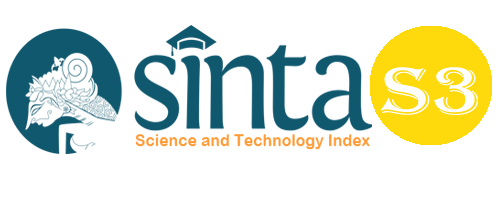The Mediating Role of Innovative Work Behavior on the Leader Member Exchange and Job Satisfaction at Indonesian Food & Beverage Services Industry during Covid 19
Abstract
Indonesian tourism, especially in the Greater Jakarta area, is not only famous for buildings, monuments, but with high diversity, Jabodetabek offers delicious culinary tours that serve special foods from all corners of the archipelago. To be able to face stiff competition in the business world, from the point of view of the current food and beverage provider organization leaders need to innovate in their work to produce employees who are satisfied with their work, so the purpose of this study is to analyze the effect of LMX on Job Satisfaction mediated by Innovative work behavior by using The quantitative method is a questionnaire via google form with a total of 249 respondents. Sample is 249 respondents. The analytical method used is SEM - AMOS 24. The results showed that LMX had a significant positive effect on IWB and Job Satisfaction , while IWB has no effect on Job Satisfaction and also IWB cannot mediate the effect of LMX on Job Satisfaction.
Keywords
Full Text:
PDFReferences
Ariani, DW (2012). Leader-member exchanges as a mediator of the effect of job satisfaction on affective organizational commitment: An empirical test. International Journal of Management, 29(1), 46.
Arif, S. (2019). Influence of Leadership, Organizational Culture, Work Motivation, and Job Satisfaction of Performance Principles of Senior High School in Medan City. Budapest International Research and Critics Institute-Journal (BIRCI-Journal). P. 239-254
Atatsi, E. A., Stoffers, J., & Kil, A. (2019). Factors affecting employee performance: A systematic literature review. Journal of Advances in Management Research, 16(3), 329-351. https://doi.org/10.1108/jamr-06-2018-0052
Bani-Melhem, S., Al-Hawari, M. A., & Quratulain, S. (2020). Leader-member exchange and frontline employees. International Journal of Productivity and Performance Management, 71(2), 540-557. https://doi.org/10.1108/ijppm-03-2020-0092
Bhatti, G. A., Islam, T., Mirza, H. H., Ali, F. H (2015). The relationships between lmx, job satisfaction and turnover intention. Sci.Int.(Lahore),27(2),1523-1526,2015. http://www.sci-int.com/pdf/636910911612074351..pdf
Carmeli, A., Meitar, R., & Weisberg, J. (2006). Self‐leadership skills and innovative behavior at work. International Journal of Manpower, 27(1), 75-90. https://doi.org/10.1108/01437720610652853
Cogliser, C. C., Schriesheim, C. A., Scandura, T. A., & Gardner, W. L. (2009). Balance in leader and follower perceptions of leader–member exchange: Relationships with performance and work attitudes. The Leadership Quarterly, 20(3), 452-465. https://doi.org/10.1016/j.leaqua.2009.03.010
Deci, E. L., Ryan, R. M., Gagné, M., Leone, D. R., Usunov, J., & Kornazheva, B. P. (2001). Need Satisfaction, Motivation, and Well-Being in the Work Organizations of a Former Eastern Bloc Country: A Cross-Cultural Study of Self-Determination. Personality and Social Psychology Bulletin, 27(8), 930-942. https://doi.org/10.1177/0146167201278002
Dorenbosch, L., Engen, M. L. van, & Verhagen, M. (2005). On-the-job Innovation: The Impact of Job Design and Human Resource Management through Production Ownership. Creativity and Innovation Management, 14(2), 129-141. https://doi.org/10.1111/j.1476-8691.2005.00333.x
Garg, S., & Dhar, R. L. (2016). Extra-Role Customer Service: The Roles of Leader–Member Exchange (LMX), Affective Commitment, and Psychological Empowerment. International Journal of Hospitality & Tourism Administration, 17(4), 373-396. https://doi.org/10.1080/15256480.2016.1226151
Graen, G.B. and Uhl-Bien, M. (1995), “Relationship-based approach to leadership: development of leader-member exchange (LMX) theory of leadership over 25 years: applying a multi-level multi-domain perspective”, Leadership Quarterly, Vol. 6 No. 2, pp. 219-247.
Heimerl, P., Haid, M., Benedikt, L., & Scholl-Grissemann, U. (2020). Factors Influencing Job Satisfaction in Hospitality Industry. SAGE Open, 10(4), 215824402098299. https://doi.org/10.1177/2158244020982998
Khan, M. N., & Malik, M. F. (2017). “My leader’s group is my group”. Leader-member exchange and employees’ behaviours. European Business Review, 29(5), 551-571. https://doi.org/10.1108/ebr-01-2016-0013
Kim, M.-S., & Koo, D.-W. (2017). Linking LMX, engagement, innovative behavior, and job performance in hotel employees. International Journal of Contemporary Hospitality Management, 29(12), 3044-3062. https://doi.org/10.1108/ijchm-06-2016-0319
Le Blanc, P. M., González-Romá, V., & Wang, H. (2020). Charismatic leadership and work team innovative behavior: the role of team task interdependence and team potency. Journal of Business and Psychology, 36(2), 333-346. https://doi.org/10.1007/s10869-019-09663-6
Megheirkouni, M. (2017). Revisiting leader-member exchange theory: Insights into stadia management. International Journal of Event and Festival Management, 8(3), 244-260. https://doi.org/10.1108/ijefm-03-2017-0022
Sang, L., Xia, D., Ni, G., Cui, Q., Wang, J., & Wang, W. (2019). Influence mechanism of job satisfaction and positive affect on knowledge sharing among project members. Engineering, Construction and Architectural Management, 27(1), 245-269. https://doi.org/10.1108/ecam-10-2018-0463
Sari, DP, & Kistyanto, A. (2020). The Effect Of Leader Member Exchange On Employee Performance Mediated By Innovative Work Behavior. MEA Scientific Journal (Management, Economics, & Accounting) , 4 (2), 88-97. https://doi.org/10.31955/mea.vol4.iss2.pp88-97
Schriesheim, CA, Neider, LL, & Scandura, TA (1998). Delegation and leader-member exchange: Main effects, moderators, and measurement issues. Academy of Management Journal , 41(3), 298-318. https://doi.org/10.2307/256909
Schyns, B., & Wolfram, H. (2008). The relationship between leader‐member exchange and outcomes as rated by leaders and followers. Leadership & Organization Development Journal, 29(7), 631-646. https://doi.org/10.1108/01437730810906362
Suharnomo, S., & Kartika, D. (2018). Leader-member exchange, job satisfaction, employee engagement, and employee performance. Diponegoro International Journal of Business, 1(2), 121. https://doi.org/10.14710/dijb.1.2.2018.121-128
Tarim, M. (2018). Impact of lmx and emotional labor on performance and commitment. International Journal of Commerce and Finance, 4 (1), 76-83, http://ijcf.ticaret.edu.tr/index.php/ijcf/article/view/65/pdf_48
Tierney, P. (2008), “Leadership and employee creativity”, in Zhou, J. and Shalley, C.E. (Eds), Handbook of Organizational Creativity, Erlbaum, New York, NY, pp. 95-123.
Tsai, Y. (2014) Learning organizations, internal marketing, and organizational commitment in hospitals. BMC Health Services Research, 14, 152.
http://dx.doi.org/10.1186/1472-6963-14-152
Yuan, F., & Woodman, R. W. (2010). Innovative behavior in the workplace: The role of performance and image outcome expectations. Academy of Management Journal, 53(2), 323–342. https://doi.org/10.5465/AMJ.2010.49388995
DOI: https://doi.org/10.33258/birci.v5i3.5786
Article Metrics
Abstract view : 154 timesPDF - 42 times
Refbacks
- There are currently no refbacks.

This work is licensed under a Creative Commons Attribution-ShareAlike 4.0 International License.

This work is licensed under a Creative Commons Attribution-ShareAlike 4.0 International License.

_.gif)

















_.gif)



